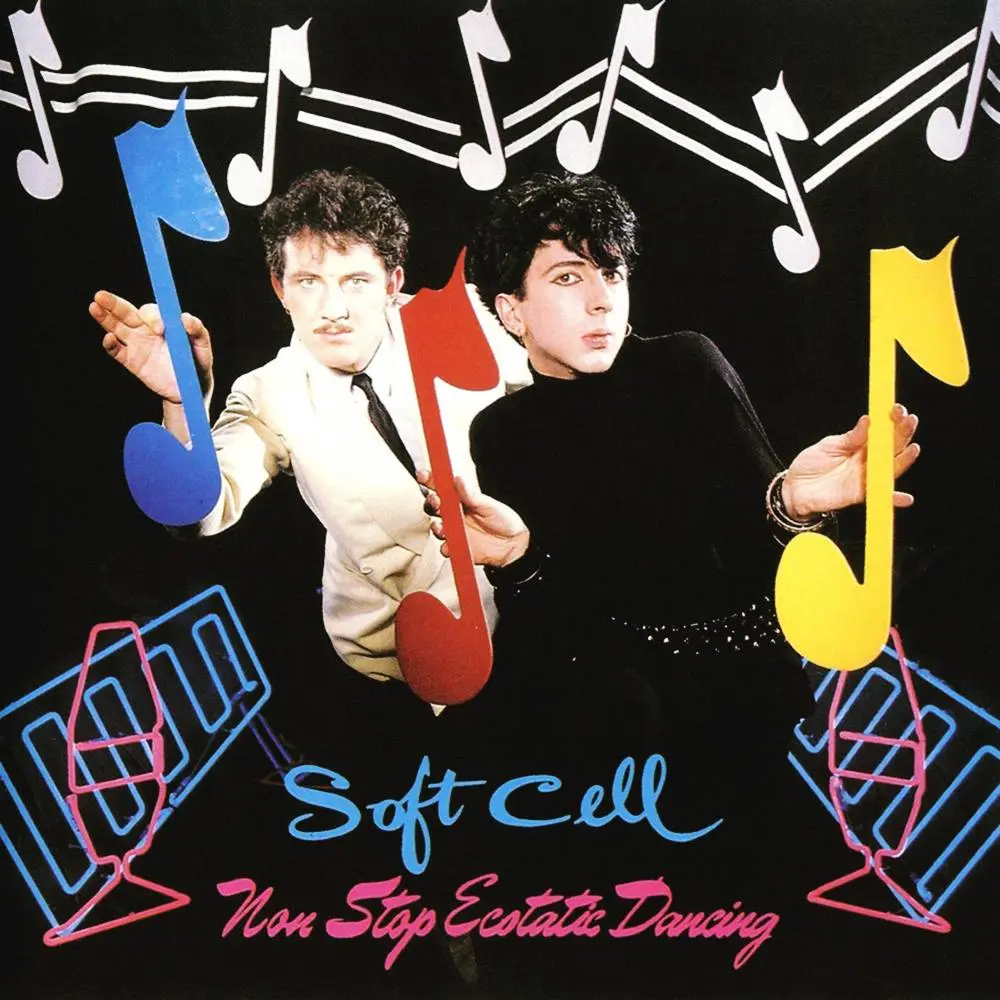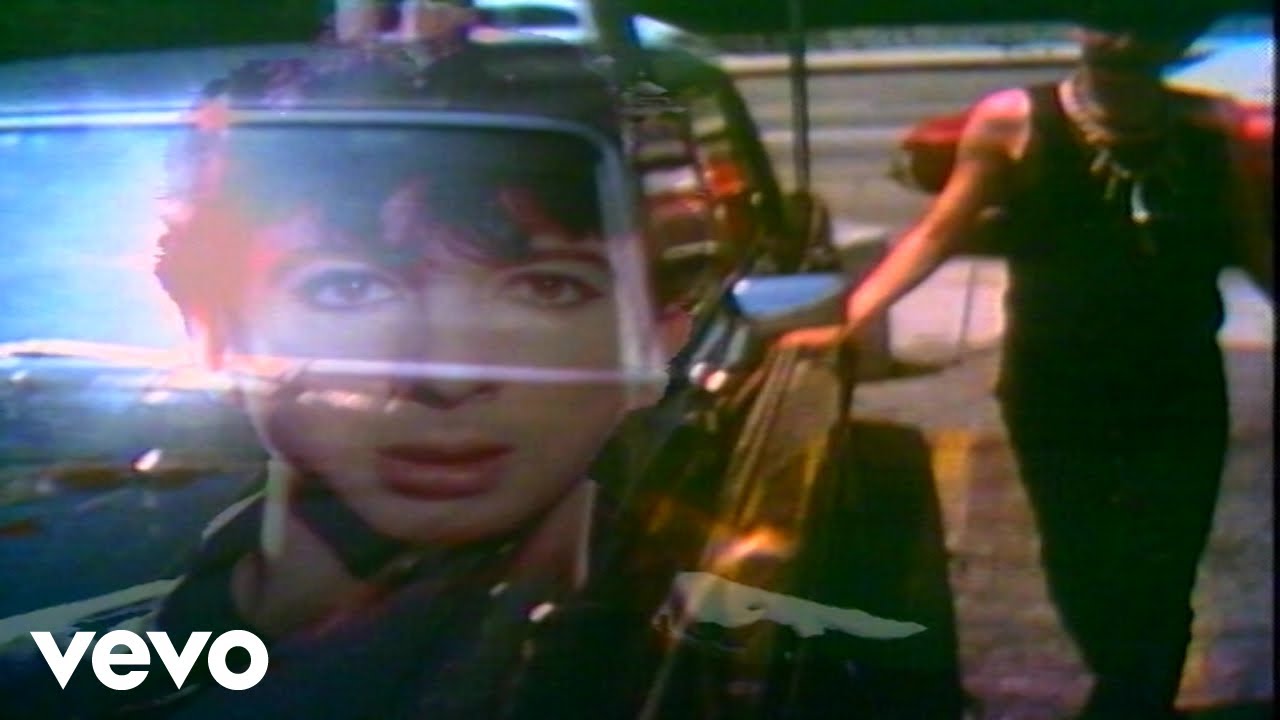In the liner notes to a new reissue of Non Stop Ecstatic Dancing, Marc Almond calls it “the first sign of a band becoming undone.” It was, he says, the point at which the balance first tipped between necessary hedonism and gradual self-destruction – though as he concedes “that’s me speaking with the benefit of hindsight.” At the time, working against the backdrop of a thriving New York club scene, fuelled by then-legal MDMA (introduced to them by their elusive guide to the night, Cindy Ecstasy, who had met an inebriated Almond after scraping him up from the floor of Studio 54) must have felt as if they were bathed in a glow that would never fade.
New York, too, was experiencing a mini-golden age that was to be similarly fleeting. Living standards were on the way back up following the recession of the 1970s, but rents were still low – a tidal wave of gentrification still a few years away. Into the copious cheap spaces that were available sprung venues and clubs soundtracked by a remarkable array of music, scenes that were each thriving in parallel and cross-pollinating – new wave, no wave, hip hop, synth pop, electronic dance music, hi-NRG and more. In May 1981, the first report on an illness that would later become known as AIDS appeared in the gay newspaper New York Native, but its most wide-reaching destruction was still a few years down the line.
Here, then, was a crucial window – Soft Cell in the thick of a city that had everything to offer them, in a position to receive it all. Post-‘Tainted Love’, they were at the peak of the fame that got them on every guestlist, lifted every velvet rope, cracked open every hidden doorway in every back alley. Cultural magpies from their earliest incarnation – in Blackpool as a teenager Dave Ball had embraced both Kraftwerk and Northern Soul; in Southport a young Marc Almond had struck parallels between pantomime, clowning and pop stardom; at Leeds Polytechnic they had absorbed everything from Weimar expressionism and 60s anarchism to schlocky horror films and Throbbing Gristle as they formed, Now, they imbibed all The Big Apple had to offer them ravenously.
And yet, work on their debut album Non-Stop Erotic Cabaret in 1981 had been a sober affair, thanks to the firm boundaries that veteran producer Mike Thorne established between professional sessions and the debauchery outside. As a result, it sounds more like the seedy underbelly of the England in which it was written, rather than the ostentatious America where it was recorded. When their label Phonogram asked for a follow-up collection of extended dance singles, however, cracks began to appear in Thorne’s dam. Then, bursting entirely. In flew the sound of the city outside – the febrile energy of Danceteria, the Mudd Club, The Roxy, The Anvil, CBGB, Studio 54, Xenon, Club A and L’Escuelita coalescing into a single cacophonic torrent, flowing into the DNA Soft Cell’s seedy little English vignettes, mutating them into dazzling trans-Atlantic hybrids.
It is this push and pull between England and America that makes the Non Stop Ecstatic Dancing version of ‘Memorabilia’, which opens the album, not just Soft Cell’s greatest individual recording, but one of the greatest in the wider history of dance music. The original had felt deeply English – more specifically northern English – in its nature. Made with the soundsystem of The Warehouse club in Leeds in mind, it has the edgy, lithe and spiky energy befitting nightlife a town where flamboyance could (and in the case of Soft Cell and their friends, often did) get you beaten on the street. Its lyrics, which Almond once described to me as “a paean to obsession and collectible trash; a serial killer collecting little bits of you ‘to show you I’ve been there,’” blend the tatty delights of a short-haul package holiday, with the kind of paranoid claustrophobia they had experienced firsthand while the Yorkshire Ripper was at large. But just as this intrinsically northern band would be transformed in New York, so too does the Ecstatic Dancing version of ‘Memorabilia’ warp those English qualities through an American lens. A once-spartan beat becomes a decadent groove; new synths and trumpets whirl in and out of focus like the lights of a club to inebriated eyes; Cindy Ecstasy herself, New York’s bacchanalian spirit embodied in human form, delivers a rap that seduces the listener to follow her down the same rabbit hole as Almond and Ball. “If you don’t believe me, ask Soft Cell, because I shook them up and I gave them hell.”
‘Sex Dwarf’, meanwhile, is even more English, inspired as it was by the kind of headline that could only appear in a Fleet Street tabloid – in this case, SEX DWARF LURES 100 DISCO DOLLIES TO A LIFE OF VICE, which Almond had spied in the News Of The World. As a result, it maintains a little more of its original character on Ecstatic Dancing than ‘Memorabilia’ – still a squalid little slice of Soho sensationalism – although once again given the expanse of a 12” dance remix and the injection of New York’s frenzied energy it stretches and warps, its edges blurring. The same goes for ‘Chips On My Shoulder’. On the original the bitterness of its narrator, wallowing in “misery, complaints, self-pity, injustice” is set wryly to a straightforward party beat. On Ecstatic Dancing, the backing becomes manic – almost fraught in its energy. Now the hedonism feels not just a contrast to the despair, but a desperate attempt to outrun it.
These three songs are thrilling even now, and yet, Almond continues in the liner notes, the album as a whole “could have been so much better.” Ecstatic Dancing is indeed a work of many flaws. Though pioneering – the first modern remix album, beating The Human League’s Love And Dancing to the punch by just a few weeks – label Phonogram (with whom Soft Cell’s relationship was to grow increasingly acrimonious) viewed it merely as a cash-in on dance music’s increasing mainstream appeal. The higher-ups baulked when Almond and Ball suggested enlisting some of their favourite DJs from the New York clubs in an attempt at authenticity and preferred to leave it to Thorne and Ball. Still under the apprehension after ‘Tainted Love’ that ‘Soft Cell do Northern Soul’ was the best route to sales, they pushed for their cover of The Supremes’ ‘Where Did Our Love Go’ that had originally formed part of a medley on the 12” ‘Tainted Love’ single to be included, along with a brand-new cover of ‘What’, originally by Melinda Marx, daughter of Groucho. Both are perfectly fine, but in this context, taking up the entirety of the A-side after ‘Memorabilia’, they serve merely as momentum-killers.
Then there are the sins of omission. The remixed ‘Insecure Me’, a B-side to the single release of ‘What’ was left out first time around, but the extended version included on the new reissue stakes a claim as one of Soft Cell’s hidden masterpieces. Then there’s ‘Torch’, released as a standalone between Non-Stop Exotic Cabaret and Non Stop Ecstatic Dancing, appeared on neither, nor (bafflingly) on their next studio album The Art of Falling Apart. The 12” mix’s inclusion here demonstrates just exactly what it was missing first time around. Ball’s moody synths settle immediately into a punchy mid-tempo strut as an ear-worm flugelhorn line swirls woozily around like neon signs to a drunkard. We’re lost deep in the warrens that Cindy, with her “avenger eyes and catlike ways” as the song puts it, led us down on ‘Memorabilia’ now, until we find her and Almond in the middle of the night, chatting with each other. What they’re speaking about on the song is banal on the surface – a dress that made her look like Billie Holiday; a song she performed onstage – but here, in the heat of Soft Cell’s long euphoric night, their babbling feels like the most important conversation in the world.
That night must have felt like it would go on forever, that the dancing really would be non-stop. Nevertheless, a brutal dawn was looming – Soft Cell would be no more within just two years of this record’s release, imploding under the pressures of fame, addiction, chaotic management and increasing acrimony with their label. This was, indeed, the sound of Soft Cell first becoming undone, a patchy record of frustrated momentum. And yet when it does hit its peaks, how dizzying, how transformational, how ecstatic that undoing still sounds.
A new reissue of Non Stop Ecstatic Dancing is out now via Universal on double LP and double CD



